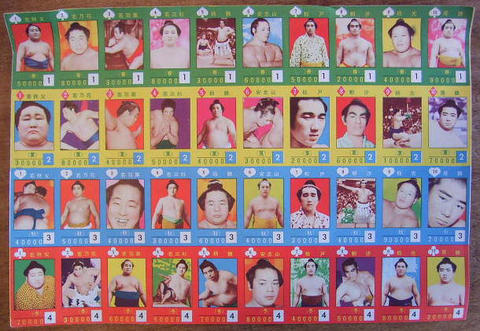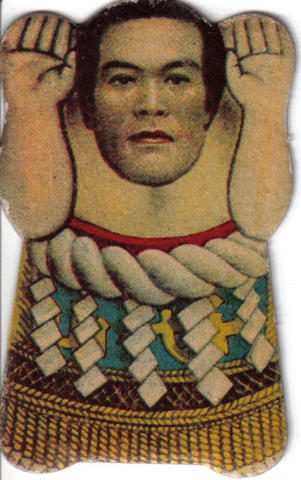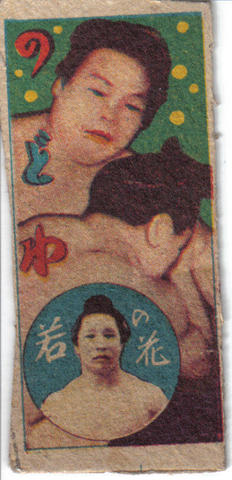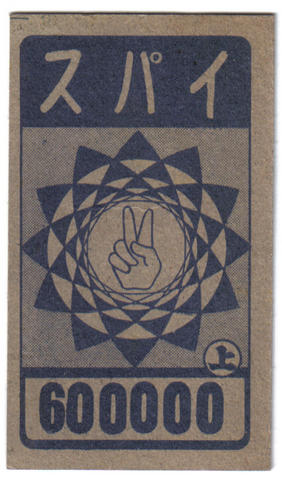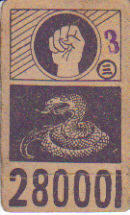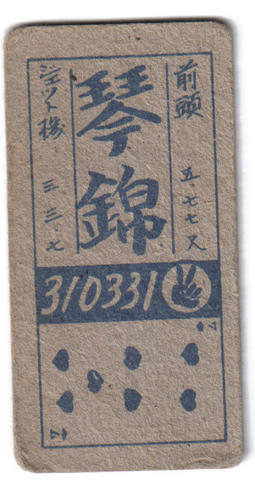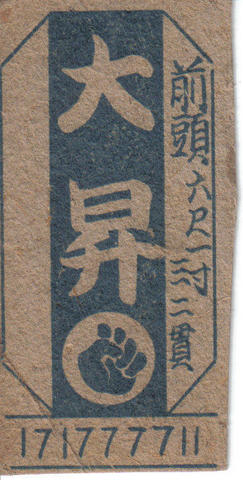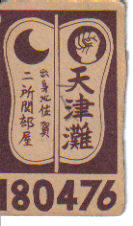|


|
Sumo Souvenirs |
|
Mark Buckton
Second of a two parter on sumo souvenirs - some hints on avoiding the fluff.
|
|
|
Konishiki |


|
Chris Gould
Takamiyama's 60s / 70s successes notwithstanding Konishiki was sumo's
first full-on mover and shaker from lands afar leaving Chris G to take
an in-depth look at the ripples the big guy left behind when exiting
the sumo pool.
|
|
|
Rikishi of Old |


|
Joe Kuroda
Joe Kuroda's looks back at the life and times of former yokozuna Shiranui.
|
|
|
Eric Evaluates |


|
Eric Blair
Eric IDs the true winners of the henkafest that was the Haru Basho senshuraku.
|
|
|
Rikishi Diary |


|
Mark Kent
Mark Kent - English pro-wrestler and amateur heavyweight sumotori -
takes his training a step further on his road to European and World
sumo glory.
|
|
|
Heya Peek |



|
Mark Buckton
Oitekaze Beya just to the north of Tokyo and not far from the abode of SFM's Ed-i-C falls under the microscope.
|
|
|
SFM Interview |


|
Carolyn Todd
Carolyn interviews Riho Rannikmaa during his recent trip to Osaka -
head of all things sumo in Estonia, friend and mentor of Baruto, this
is a man with something to announce.
|
|
|
Sumo à la LA |


|
Alisdair Davey
SFM's man in the shadows reports on his recent jaunt in LA, as guest of
the Californian Sumo Association and SFM reporter at large.
|
|
|
Photo Bonanzas |


|
Hot on the heels of the recent Ise bonanza - Haru up close and very very personal - some of our best pics to date.
|
|
|
Haru Basho Summary |


|
Lon Howard
Lon wraps the Haru Basho and chucks in a few bits on the henka issues the top dogs are suffering from at present.
|
|
|
Sumo Menko |


|
Ryan Laughton
Sumo cards of old brought to life once again by expert collector Ryan
Laughton. None of your BBM offerings here - Pt II of III.
|
|
|
Natsu Ones To Watch |



|
Carolyn Todd
Carolyn ponders the ones to watch come May and Natsu when sumo comes home to Tokyo.
|
|
|
Kimarite Focus |
|
Mikko Mattila
Mikko's latest look at sumo's kimarite offers unequalled analysis and in depth explanations.
|
|
|
Amateur Angles |


|
Howard Gilbert
On your marks, get set, go - Howard Gilbert walks us through the months ahead on the amateur calendar.
|
|
|
Kokugi Konnections |



|
Todd Lambert
Click on Todd's latest selection of the best sumo sites the WWW has to offer.
|
|
|
Fan Debate |
|
Facilitator - Carolyn Todd
Should it or shouldn't it? Honbasho go on the overseas road that is.
See what SFM's Chris Gould and James Hawkins have to say.
|
|
|
SFM Cartoons |

|
Benny Loh & Stephen Thompson
In this issue's cartoon bonanza, sit back and sample ST's latest artistic offerings.
|
|
|
Sumo Odds & Ends |
|
SFM's interactive elements - as always includes Henka Sightings, Elevator Rikishi and Eternal Banzuke!
|
|
|
Let's Hear From You |

|
What was it that made you a sumo fan - A. S. - the face in the crowd
reveals almost all - to see everything you'll have to close your eyes.
|
|
|
Readers' Letters |


|
See what our readers had to say since we last hit your screens.
|
|
|
Sumo Quiz |
|
The Quizmaster
Answer the Qs and win yourself a genuine banzuke.
|
|
|
 |
|
run across any of these, I wouldn’t hesitate to pick them up right away.
The final part of the production process is how individual menko were
cut from their master sheet after printing. All the rikishi
series menko were die-cut, which is essentially the same process as how
monetary coins are made. A big stamp came down and stamped out
the menko, but left parts of the master sheet as unusable. It
also tended to produce off center menko as is seen with many of the
menko produced in this fashion. This technique was more costly
than the second method that produced the simple rectangular shaped
menko seen on 95% of all sets. Rectangular shapes were relatively
easy to make, as all that was needed was essentially a huge paper
cutter to cut stacks of master sheets into individual menko.

A variation on this method that the companies used was to print the
master sheets and then sell them intact or include them as prize sheets
where the kids had to cut them apart themselves. This was a
further attempt at reducing production costs, as no cutting was
required at the factory. One result of this, though,
Three examples of cutting production: Sheet, Die-Cut and Hand-Cut
|

|

|

|
is
that many menko that survive today are those cut from sheets by the
kids, and so have many wavy edges and are off-centered to some
degree. I have yet to notice an effect on game play from the
different cutting methods.

Now that we’ve talked about the front of the menko, let’s move to the
back. The backs of sumo menko came in all sorts of themes such as
Chinese Zodiac signs, war images or outer space drawings, but the two
basic types that are consistent on all the menko after 1950 are the
Gu-Choki-Pa (Rock-Scissors-Paper) mark and Fighting Numbers.
These were used in the different variations of menko game rules.
Instead of slamming the menko on the ground trying to flip the
opponent’s menko over, the kids could simply pull out different menko
and use the Gu-Choki-Pa marks to outplay their opponents. The
Fighting Numbers were also used to play a variation of menko. See
last issue’s Sumo Menko Basics article for more details on the
variation of these games. The emergence of the Gu-Choki-Pa marks
on sumo menko is first seen at the beginning of the 1940s and is
standard until 1964, but the 1930s menko only have Fighting
Numbers. I’m still looking into this to see if this was an across
the board menko trend or just on sumo menko. Menko backs are very
important in set identification, which we’ll discuss in further detail
in the next issue of SFM.
For those of you interested in collecting, I’ve tried to provide a good starting point at www.sumo menko.com,
where there are numerous photos of different menko and checklists for
the set collectors. I’ve also tried to provide a general overview
of all things sumo menko on the front. The big thing will be
finding a good source of sumo menko. There is almost always an
auction or two on eBay from four or five different sellers. This
is a great
|

|

|

|
Examples of Gu-Choki-Pa marks and Fighting Numbers on back of menko
place to start building up your collection at reasonable prices. Rob at Prestige Collectables, www.prestige collectibles.com,
has an online auction up every couple of months with some unique and
sometimes very hard to find sumo menko. There are also a couple
of random online stores in the US that sell one or two sumo menko, so
just Google “sumo menko” or “sumo card” and you might be able to find a
good buy out there. In the next issue of SFM we’ll discuss set
identification techniques along with the lottery aspect of sumo
menko. I’ll also highlight a few of the sets during this time
along with the rikishi that made them so popular. Until then,
cheers….
|
|

